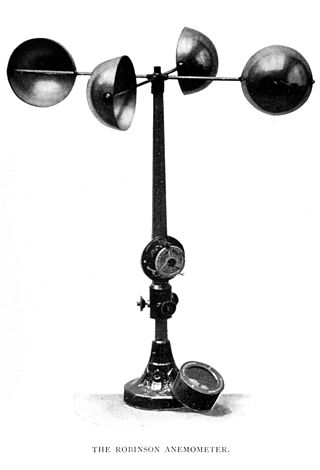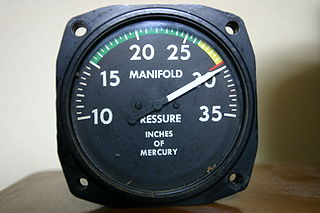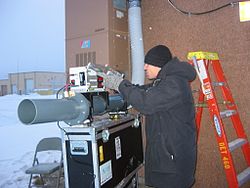
In meteorology, an anemometer is a device that measures wind speed and direction. It is a common instrument used in weather stations. The earliest known description of an anemometer was by Italian architect and author Leon Battista Alberti (1404–1472) in 1450.

A pitot tube measures fluid flow velocity. It was invented by a French engineer, Henri Pitot, in the early 18th century, and was modified to its modern form in the mid-19th century by a French scientist, Henry Darcy. It is widely used to determine the airspeed of aircraft; the water speed of boats; and the flow velocity of liquids, air, and gases in industry.

In meteorology, wind speed, or wind flow speed, is a fundamental atmospheric quantity caused by air moving from high to low pressure, usually due to changes in temperature. Wind speed is now commonly measured with an anemometer.
Flow measurement is the quantification of bulk fluid movement. Flow can be measured using devices called flowmeters in various ways. The common types of flowmeters with industrial applications are listed below:
The cubic foot is an imperial and US customary (non-metric) unit of volume, used in the United States and the United Kingdom. It is defined as the volume of a cube with sides of one foot in length. Its volume is 28.3168 L.
An oxygen sensor (or lambda sensor, where lambda refers to air–fuel equivalence ratio, usually denoted by λ) or probe or sond, is an electronic device that measures the proportion of oxygen (O2) in the gas or liquid being analysed.

A mass flow meter, also known as an inertial flow meter, is a device that measures mass flow rate of a fluid traveling through a tube. The mass flow rate is the mass of the fluid traveling past a fixed point per unit time.
Actual cubic feet per minute (ACFM) is a unit of volumetric flow. It is commonly used by manufacturers of blowers and compressors. This is the actual gas delivery with reference to inlet conditions, whereas cubic foot per minute (CFM) is an unqualified term and should only be used in general and never accepted as a specific definition without explanation. Since the volumetric capacity refers to the volume of air or other gas at the inlet to the unit, it is often referred to as "inlet cubic feet per minute" (ICFM).

The manifold absolute pressure sensor is one of the sensors used in an internal combustion engine's electronic control system.

A mass (air) flow sensor (MAF) is a sensor used to determine the mass flow rate of air entering a fuel-injected internal combustion engine.
Standard cubic feet per minute (SCFM) is the molar flow rate of a gas expressed as a volumetric flow at a "standardized" temperature and pressure thus representing a fixed number of moles of gas regardless of composition and actual flow conditions. It is related to the mass flow rate of the gas by a multiplicative constant which depends only on the molecular weight of the gas. There are different standard conditions for temperature and pressure, so care is taken when choosing a particular standard value. Worldwide, the "standard" condition for pressure is variously defined as an absolute pressure of 101,325 pascals, 1.0 bar, 14.73 psia, or 14.696 psia and the "standard" temperature is variously defined as 68 °F, 60 °F, 0 °C, 15 °C, 20 °C, or 25 °C. The relative humidity is also included in some definitions of standard conditions.

An air flow bench is a device used for testing the internal aerodynamic qualities of an engine component and is related to the more familiar wind tunnel.
An air-fuel ratio meter monitors the air–fuel ratio of an internal combustion engine. Also called air–fuel ratio gauge, air–fuel meter, or air–fuel gauge, it reads the voltage output of an oxygen sensor, sometimes also called AFR sensor or lambda sensor.
Airwatt or air watt is a measurement unit of the effectiveness of vacuum cleaners which refers to airflow and the amount of power (watts) a vacuum cleaner produces and uses. It can also be referred to as a measurement of the energy per unit time of the air flowing through an opening, which is related to the energy that electricity carries through the power cable (wattage).
The Glossary of fuel cell terms lists the definitions of many terms used within the fuel cell industry. The terms in this fuel cell glossary may be used by fuel cell industry associations, in education material and fuel cell codes and standards to name but a few.
Air changes per hour, abbreviated ACPH or ACH, or air change rate is the number of times that the total air volume in a room or space is completely removed and replaced in an hour. If the air in the space is either uniform or perfectly mixed, air changes per hour is a measure of how many times the air within a defined space is replaced each hour. Perfectly mixed air refers to a theoretical condition where supply air is instantly and uniformly mixed with the air already present in a space, so that conditions such as age of air and concentration of pollutants are spatially uniform.

The clean air delivery rate (CADR) is a figure of merit that is the cubic feet per minute (CFM) of air that has had all the particles of a given size distribution removed. For air filters that have air flowing through them, it is the fraction of particles that have been removed from the air, multiplied by the air flow rate through the device. More precisely, it is the CFM of air in a 1,008-cubic-foot (28.5 m3) room that has had all the particles of a given size distribution removed from the air, over and above the rate at which the particles are naturally falling out of the air. Different filters have different abilities to remove different particle distributions, so three CADR's for a given device are typically measured: smoke, pollen, and dust. By combining the amount of airflow and particle removal efficiency, consumers are less likely to be misled by a high efficiency filter that is filtering a small amount of air, or by a high volume of air that is not being filtered very well.
Airflow, or air flow, is the movement of air. The primary cause of airflow is the existence of air. Air behaves in a fluid manner, meaning particles naturally flow from areas of higher pressure to those where the pressure is lower. Atmospheric air pressure is directly related to altitude, temperature, and composition.








